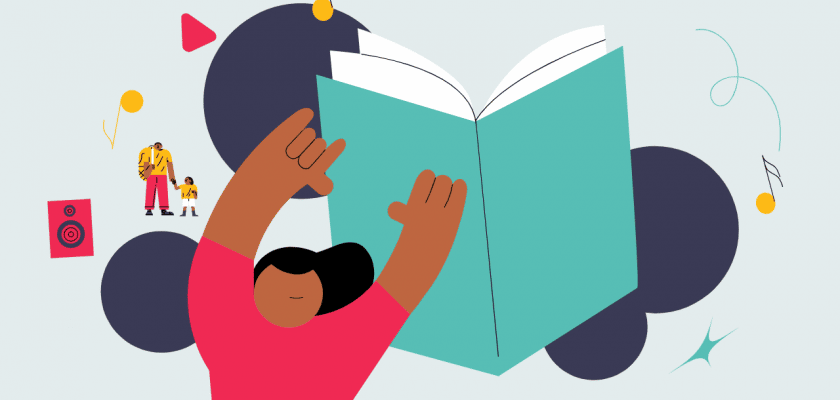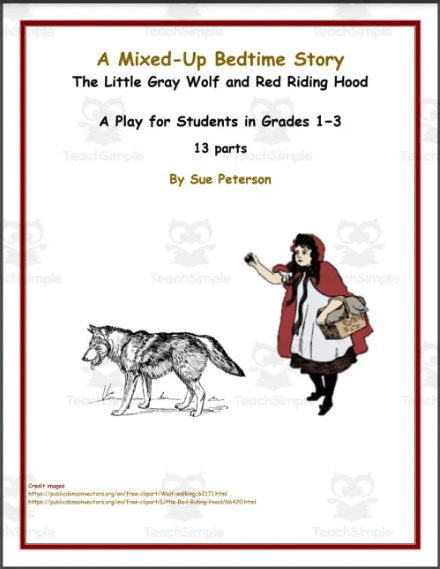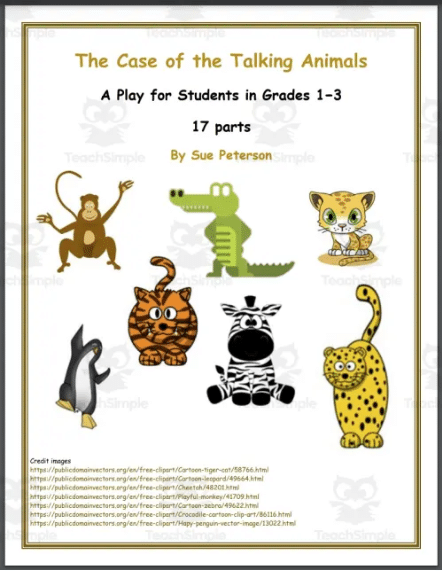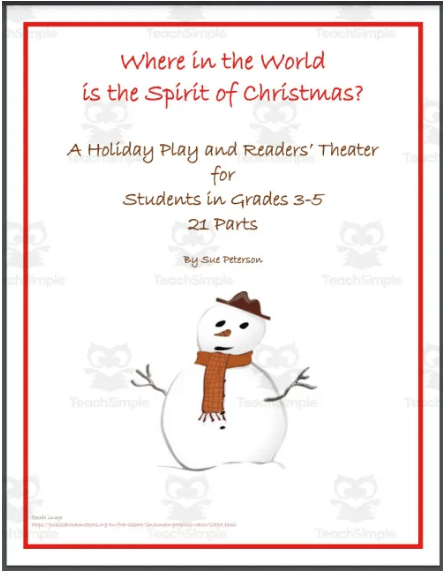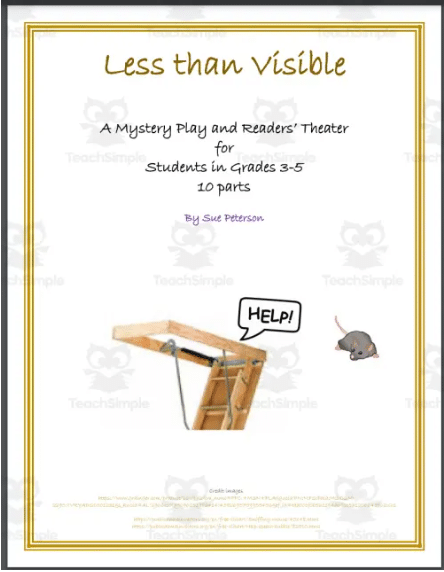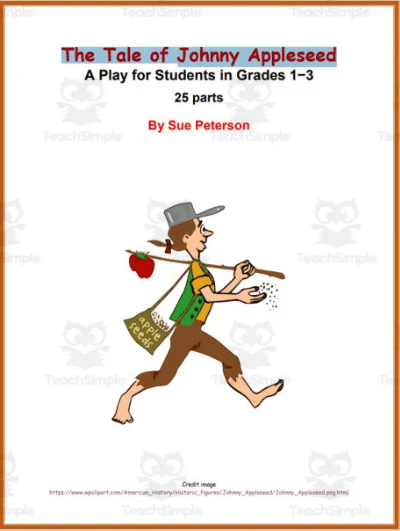Reading out loud in the classroom is a valuable experience for emerging readers. Choral reading offers teachers the chance to have every student in the classroom practice their reading out loud. This method is helpful to make sure kids practice a lot and it lets students get help quickly if they don’t know a word.
Table of Contents
- What Is Choral Reading?
- What Are the Benefits?
- Types Of Choral Reading
- When to Use Choral Reading
- Strategies for Struggling Readers
- Strategies for Younger Students
- Using Choral Reading With Technology
- What Types Of Content Are Best For Choral Reading
- Choral Reading FAQ’s
The only way that beginning readers will grow more comfortable and proficient with their reading is to practice. Students who read at home with their parents and older siblings experience a huge boost over those who aren’t exposed to print in the home. However, the classroom is where the majority of reading instruction needs to take place. While parents can reinforce learning, most parents aren’t equipped with the tools and strategies to teach their young readers all they need to know to become fluent readers who decipher and comprehend language.
What Is Choral Reading?
Choral reading is the practice of having younger students all read out loud from the same text, at the same pace. The result sounds like a chorus. As students read aloud together, they can rely on one another to make out the words and can listen to their friends for assistance as needed, rather than purely relying on context clues. Choral reading exercises allows the teacher to have a chance to hear the entire class read. When the teacher moves around the room and listens to each student, they can make sure everyone is joining in and reading the text correctly.
Here is an example of what choral reading can look like in the elementary classroom:
What Are the Benefits?
Why do teachers use choral reading? This is one teaching strategy that is beneficial for several reasons: engagement, classroom management, and reading aloud instruction.
Choral reading session offers readers who are less skilled the chance to practice their reading out loud and receive immediate support with their reading skills, which is beneficial before being required to read on their own—especially before reading out loud on their own in front of their peers. This strategy also provides a model for fluent reading, as students read the passage aloud, they will listen to their classmates pronounce words. Students will work to keep pace with the other members of their class, which means they’ll need to be quick to identify sight words.
All these factors contribute to making choral reading a smart choice for teachers of young readers.
The Data: Choral Reading & Fluent Reading
Choral reading helps new and beginning readers to read smoothly, learn more words, and feel more confident. In studies, there are different types of group reading, like the whole class reading together or echo reading. In echo reading, the teacher reads first, and then the students repeat what was read.
The whole class choral reading, on the other hand, occurs in unison. Typically, the teacher will read along with the students as well, which allows the teacher to model accurate pronunciation.
In 2018, researchers Kodan & Akyol studied how group reading helps students who have trouble reading in class. They studied to see how choral reading affected understanding and knowing words.
The study found that most students did better in understanding the text and knowing words after group reading. The chart shows how much students improved with different types of texts. This research showed that students who struggled the most had the biggest improvement from group reading.
Types Of Choral Reading
There are several different ways that choral reading can be implemented in the classroom. Each method has benefits. The best method to use in your classroom can be determined based on your student’s needs. Rotating through these methods as needed is a great way to differentiate for the readers you are working to support.

Primary of whole class choral reading strategy
Echo
The teacher reads an excerpt and then the class repeats what was read out loud, creating an echo.
Antiphonal
The class is split up into two groups and reads in turns.
Dialogue
Different members of the class are assigned a role in the text and are responsible for reading their part out loud.
Cumulative choral reading
The entire class reads a copy of the text together, out loud.
Impromptu Choral Reading
The text is being read out loud by the teacher, and students are encouraged to jump in and read along but are not required to do so. This provides students with additional autonomy and choice, which are helpful strategies for encouraging students to love learning.
Performance Reading
Students are given a passage ahead of time and are given time to practice it before reading out loud, as a performance. Researchers Jennings, Caldwell & Lerner (2014) found that this is an especially helpful strategy for low-level readers as it provides them with a chance to feel confident in their reading before reading in front of their peers.
When to Use Choral Reading
Choral reading can be used as part of any classroom strategy, including at the primary and secondary levels. Using choral reading at the secondary level is a great way to ensure that students are actually reading the text themselves. At the primary level, choral reading activities can be used across the curriculum.
Here are ways to use choral reading in the elementary classroom:
Language Arts
Use choral reading to help students develop fluency and to decipher complex texts. This can be used when reading a story, which will provide a quality foundation to then break down parts of the text for deeper analysis, such as looking at the plot and sequence of events.

Social Studies
Choral reading is a great tool for covering the basics of a history lesson. It can be used with primary documents, as well, such as the Bill of Rights. There are even School House Rock videos that students can sing along to while engaging in choral reading.
Science
Choral reading is a great way to make sure that students know the instructions before starting a lab or classroom experiment. This is a great way to emphasize certain parts of information during a science lesson.
The Arts
This strategy can be used to review types of arts and methods within the arts so that students have practical knowledge of the medium before learning more about the artwork itself.
Strategies for Struggling Readers
Choral reading can be particularly helpful for struggling readers. Here are some strategies to better support these students during choral reading sessions.
1. Pairing Struggling Readers with Stronger Readers
Pairing a student who has trouble reading with a better reader during group reading can help. This gives extra support and shows good reading. It can make the student feel more confident and let them hear the right way to say words and read at a good speed from their partner.
2. Pre-reading Exposure
Before group reading, let students who have trouble reading see the text first. You can read it out loud, use a recording, or let them look at it alone. This helps them feel better and more sure of themselves when they join in group reading.
3. Targeted Instruction
When helping students who have trouble reading, find what areas they need more help in, like sounds, smooth reading, or understanding. Add focused teaching and activities into group reading for these areas. For example, pick texts that have certain sound patterns or use word games connected to the group reading text.

Strategies for Younger Students
Choral reading can also be a beneficial tool for young readers who are just beginning their journey into literacy. Here are some strategies to better support young readers during choral reading sessions.
1. Repetitive and Rhythmic Texts
Pick texts with repeating parts, rhyming, and a beat to make group reading more fun and easier for young readers. These texts can help them read smoothly, and repeating parts lets them guess and join in the reading more simply.
2. Visual Supports
Use pictures and drawings to help young readers understand better during group reading. When students can see what the story is about, they can understand and be more interested in the reading.
3. Grouping by Skill Level
Put young readers in small groups based on their reading skills. This lets them practice group reading with others at the same level, making a helpful and safe place to learn.
4. Use of Puppets and Props
Young readers can enjoy using puppets or props during group reading. These things make the reading more fun and help students get more into the story.
5. Incorporate Movement and Song
Connect group reading to movement and singing for young readers. Add actions, clapping, or singing to make them more interested in the text and remember it better. Using different senses helps young readers create a better link to the story and understand it more.
Using Choral Reading With Technology

Using technology in your classroom to support choral reading is a great strategy. Students can follow along as the words come across the screen in large, bolded text. This is helpful for students who are struggling with sight words, as well as for those who may be visually impaired.
When using this reading strategy to teach core information, such as in science instruction or when reviewing math formulas, it can also be helpful to play music so that students are able to put the information to a rhythm in their minds. This can help with recall down the road.
Young readers may also benefit from using a prop like a “reading phone,” which is a basic plastic pipe that allows them to hear their own reading in their ears.
Using scripted plays is a great way to incorporate choral reading into your instruction. These plays can be practiced over and over again so that students get familiar with the words and are able to master the content. They can also be used as a fun one-day activity to bring a seasonal theme into your instruction.
What Types Of Content Are Best For Choral Reading
All subjects can be covered with choral reading. Primary-level teachers can use choral reading to support aspiring readers. Choral reading helps with pacing and pronunciation. Secondary teachers can use choral reading to cover complex aspects of content that will be discussed in detail following the initial reading.
Scripted Resources For To Use:
A Mixed Up Bedtime Story By Sue Peterson
The story opens with a mother telling her children a bedtime story featuring a little gray wolf who visits her grandmother. The wolf’s mother warns of being careful in the woods as the woodcutter and Red Riding Hood love to capture wolves as pets. The wolf meets many animals (e.g., a frog, snake, rabbit, and chipmunk) along the path who offer advice on being safe. When the wolf knocks on Grandmother’s door, Red Riding Hood is there to trick him. You’ll have to read the rest of the story to find out who saves the day, where Grandmother is hiding, and how they can now live happily ever after.
The Case Of The Talking Animal By Sue Peterson
On a trip to the zoo, the children hear the animals talk. The zoo might need to close. And when the animals sneak out of their cages, the children and the animals enjoy sharing their talents. Little do they know that two old very rich ladies are listening and they want to help out!
Where In The World Is The Spirit of Christmas By Sue Peterson
Detective John T. Brown travels the world to solve the case Where in the World is the Spirit of Christmas. Along the way, he meets children from Israel, Germany, the Netherlands, Poland, Mexico, and Sweden in hopes of finding the Grinch who is missing the holiday spirit. Come and see how others around the world celebrate this holiday and how the Grinch learned that Christmas is really much more than things.
Less Than Visible By Sue Peterson
Fun Mystery Theater – If you are up for a fun mystery and like brownies, then you are sure to enjoy this play! Will there be an end to the disappearing characters?
The Tale Of Johnny Appleseed By Sue Peterson
Listen to the animals (the rabbit, fox, birds, deer, snake, and bear cubs) and help Johnny Appleseed tell the folk story about how apple trees came to grow all over the countryside. A pioneer family, Native American Indians, and the trees also share about Johnny Appleseed’s life.
Books That Work Well For Choral Reading
The best books to use for choral reading are those that have a lot of repetition and natural rhythm to them. Think Brown Bear, Brown Bear.
- The Dinky Donkey, by Craig Smith
- Dragons Love Tacos, by Penguin Books
- Those Darn Squirrels!, by Penguin Books
- Wake up Crabby, by Jonathan Fenske
Choral reading is a proven strategy that can help students of all abilities, but especially young and emerging readers. By working together, students will develop more awareness of sight words and stronger pronunciation.
Choral Reading FAQ’s
Choral reading can be used in the elementary or secondary classroom as a way of helping students learn to read and master content.
Students benefit from choral reading as a way of mastering fluency while reading. This is a beneficial way for a teacher to support student reading in the classroom, both for reading and content instruction.
To differentiate while using choral reading, break students into groups or offer students the chance to echo read. This will help faster learners be able to work at a quickened pace.
There are a lot of benefits of choral reading. This is a good strategy to use in place of silent reading when students are reading the same text. Overall, choral reading is worth trying.
